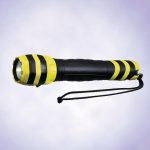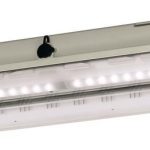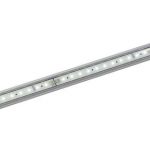A range of different lights are required in hazardous areas, e. g. individual luminaires, floodlights, compact luminaires or even full-scale emergency lighting solutions complete with a central battery system. One major trend in recent years is the increasing popularity of LED technology for more and more of these and other types of lamp – with substantial benefits for end users.
Author Dr. Andreas Kaufmann Head of Business Unit Lighting and Signalling Devices, R. Stahl Schaltgeräte
The reasons for the rise of LEDs are economic as well as technological. The price of light emitting diodes has come down considerably in recent years as improved manufacturing meth-ods have taken hold and production quantities have multiplied. At the same time, high-performance diodes have been constantly enhanced and now offer an excellent light yield. In addition, several LED characteristics are particularly well suited to harsh industrial environments. For one thing, LEDs are practically insusceptible to vibration. Moreover, in hard-to-access locations, they enable compact lighting solutions including intelligent systems that automatically adjust to changing ambient light sources. LEDs also achieve several times the life span of incandescent or fluorescent lamps. Notably, the energy efficiency of LED luminaires – and with it their service life – actually increases at low temperatures. That makes LED lighting ideal for applications in very cold environments, e. g. oil and gas industry facilities in Arctic regions. Of course, this is a segment that is simultaneously notorious for the prevalence of hazardous areas.
Versatile range of LED luminaires
LEDs became popular early on for hand lamps and torches. These devices used to be fitted with incandescent lamps with a relatively short life span which only achieved a moderate light yield. In LED versions, the internal resistance of the batteries is now usually sufficient to ensure a constant supply current. The fact that LEDs are typically limited to a narrow beam is largely irrelevant for these luminaire types. LEDs are becoming the technology of choice in signal lamps. These benefit from the instant start functionality of LEDs as well as from their tolerance of frequent switching with no negative repercussions for their service life. The low energy intake and therefore low intrinsic heat is another vital aspect that enables highly effective, yet at the same time extremely efficient, signal light solutions. A somewhat more recent development is the foray of LED technology into the field of general-purpose light fittings. Until a few years ago these luminaires used to be the strongest domain of classic illuminants. LED-based models such as the Exlux 6002 and 6402 lines from R. Stahl, for example, now serve as very energy-efficient general lighting solutions in Ex zones 1/21 and 2/22: one 52 W model of these LED devices can replace two standard 36 W fluorescent lamps while ensuring a much better life span of 100,000 operating hours. Given its high luminous flux of 5800 lm, it also achieves an excellent light yield that surpasses 100 lm/W. The luminaires in this series feature slim, flat GRP housings with increased safety”Ex e protection for the 6002 line or restricted breathing Ex nR protection for the 6402 line. The housing is the same as the tried-and-tested enclosure for the conventional fluorescent lamps in the Exlux 6001 line.
Life cycle cost reduction
All accessories are likewise compatible – existing facilities can therefore be easily modified or retrofitted with LED technology. What’s more, the new units weigh at least a third less than comparable, competing standard products, which further facilitates handling. R. Stahl additionally offers compact LED-based tubular light fittings for use in Ex zones 1/21 and 2/22, providing users with an innovative alternative to typical linear luminaires. With a diameter of just 55 mm, these lights take up less than half the space required by conventional linear luminaires and are about half the weight. The tubular design makes the new 6036 series extraordinarily light-efficient: 30 such LED-based fittings with a length of four feet (1240 mm), for instance, ensure an illuminance of approximately 500 lx. That would usually require 35 linear luminaires with two 36 W fluorescent tubes each or as many as 48 conventional box-type units retrofitted with LEDs. However, R. Stahl’s lights consume only about half as much power and the specific power consumption per 100 lx amounts to a mere 1.5 W/m². The operating expenses are therefore greatly reduced – realistic cost savings range from some 20 % to more than 50 %, depending on the time frame and the specific solutions compared. The luminaires can also be fitted with a light sensor to enable them to be switched off automatically as long as sufficient ambient light is available. In this case, the cost may be even lower in some applications.
Non-LED luminaires for hazardous areas
Of course, LEDs are not the only lighting option for hazardous areas. There are also novel developments for luminaires using conventional illuminants. For example, R. Stahl recently introduced a generation of robust, hazardous area light fittings with regular illuminants in the Exlux 6001 line. These achieve a higher energy efficiency and provide approximately 10 % more luminous flux than otherwise comparable products. The current Exlux 6001 luminaires for use in Ex zones 1/2 and 2/22 also feature a design that is considerably more compact, stable and torsion-resistant than the preceding generation. Depending on their performance class, 6001 series luminaires are a quarter to a third lighter than their predecessor models or similar products in this category. Other notable developments by R. Stahl are extra-tough signalling devices for use in Ex zones 1/2 and 2/22. FX 15 series beacons are designed to withstand extreme environmental conditions, e. g. a wide ambient temperature range from 55 °C to +70 °C. The GRP enclosure combined with a stainless steel guard and fixings adds up to a corrosion-resistant product. The light source is a xenon tube providing a high light output. A polycarbonate Fresnel lens helps to direct and enhance the impression from the 5 J xenon flash. FX15 series beacons with a clear lens produce an excellent luminous intensity of 49 cd effective.
cpp-net.com/0115430
Share:









